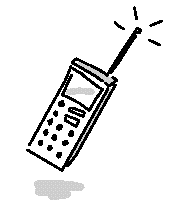
Diamantino Freitas, John Gjoderum, Gunnar Hellstrom and Mathijs Soede
Introduction
More than a century after Bell's invention of the telephone, a new wireless communications revolution is developing that will at last free users from the phone cord. A vision of the future for wireless communications could be simply stated: to provide by the early 2000s to everyone who needs it, the access to a pocket-sized personal communicator, through which, she (he) will be able in most of the populated areas within Europe to make contact with and be contacted by other users.
Small size and portability are the basic reasons for the recent success of the mobile approach to telephony. Cordless phones can be a benefit to elderly and disabled users enabling them to use the phone everywhere inside their homes. Mobile phones extend this possibility to the outside world. Mobility impaired persons, for example, who might have difficulties in reaching a ringing telephone, have the opportunity to possess a mobile telephone close at hand. Many elderly and disabled users feel a reassuring sense of security in the event of an emergency by carrying a mobile or cordless phone.
At the same time, the new digital mobile telephony networks are being built over a modern network technology that allows a set of services to be set up, with flexibility. This is why it is important to consider the fact that all mobile communication users have their personal needs. In particular, elderly, disabled and chronically ill people will need in addition special facilities. It is interesting to note that many times these special facilities have also turned out to be quite useful for persons without a disability.
Having a mobile communication unit with you opens up a wealth of possibilities for new services and applications. Those applications (services) designed for people with special needs will also stimulate improved services for everybody. Some examples of new services/applications are given below.

(Figure 4-12) Mobile telephones are increasingly in demand due to their flexibility.
Advantages of Mobile Telephones
The enhanced facility in reaching or handling the telephone set will obviously contribute to an acceleration in development and implementation of services and interface solutions for a wide range of persons with disabilities.
Furthermore, the basic concept of a body-worn keyboard, (the mobile phone unit) is opening up a complete range of communication services. Such a communication keyboard might suggest a large range of other functions which at this moment are related to the use of a personal computer (calculator function, electronic diary, etc.).
Categories of Application
Dealing with or handling emergency situations, supplying continuous care and surveillance is one important category of applications. Some examples include:
Immediate consultation with a physician is possible. Also when precise medication is critical, it is often a reason to keep a patient in hospital. With (automatic) telephone contact between hospital and patient, early dismissal could be considered.
A second category of applications is related to the local situation: the telecom user's actual environment. In this category some examples of services could be:
A third category concerns very special services related to a specific impairment. Examples of these services could be:
Some disability related examples are given below.
Physical Impairment
A large number of persons obliged to use a wheelchair will not be restricted in the use of telephone communi-cation any more if they can acquire a mobile phone. There is no more need to struggle with a wrongly designed telephone booth, or to reach the nearest fixed phone (sometimes downstairs).
However, besides the "hands-free" operation, some people with impaired mobility, who are not able to handle any push-button type of telephone set, need a voice interface for dialling. Some solutions already exist for voice command interface of the telephone, for example COVOTEL in France, that could be adapted. It is of course still today very difficult to make a simple word recognizer work in a noisy environment, but at least in the home or in another relatively quiet place the recognition should be quite reliable.
Hearing Impairment
The same basic difficulties exist as with the classic fixed phones. There are nevertheless some possibilities that are introduced by the portability of the mobile telephone. For instance, although a hearing impaired person may still not be able to hear the telephone "beep", the use of a vibrating transducer and a flashing light could alert the user of an incoming call and that she (he) should turn on the set. Also the use of low-frequency alerting tones is of great importance to hearing impaired persons.
Another possibility is introduced by the presence of an alphanumeric display. Sending a hard of hearing or deaf person a text message using the phone keyboard, would in principle be possible but very difficult with the present sets. In any case, some special operations could be programmed to allow some basic form of text communication.
Another possibility is emerging with the automatic relay service (speech recognizer) which can convert the incoming speech and show its contents in text form on the telephone display (see chapter 4.3 p.133). This recognition is still not very reliable on the telephone line; it is the main theme being developed by COST 249 - "Speech recognition over the telephone line".
Visual Impairment
The problem of not finding the telephone is immediately solved because the phone is always being worn. Problems with keypad handling and reading of the display remain however. Tactile cues over the keypads and manufacturers compliance to the standards would be of great help to blind users. Besides the dot on the 5-key, a standardized tactile marking of the two keys "off hook" and "on hook" is essential. It should also be possible to convert the operational information displayed into speech. For partly sighted users it is of great importance to be able to choose contrasting colours used on the phone such as for instance, white keys on a black body.
Speech Impairment
Basically a speech impaired user could use the keyboard to produce a text message. For a more dynamic conversation, a text-to-speech converter and a suitable keyboard could be attached to the mobile set to allow the emission of text.
Cognitive Impairment
Keyboard alterations leading to a one- or two-button phone, could provide a solution for some persons with mental disability. In this case the phone would be a one- or two-button phone with printed representations on it e.g. pictograms.
Emergency calls can be automatically redirected to a specific location that the customer indicated as being the emergency service provider. This can be of help in case the customer needs special resources or precautions when a distress call from a mentally impaired person, for example, needs specific psycho-logical attention.
General - Use of Data Communication
The mobile GSM (Global System for Mobile Communication) network offers data communication functions through a data channel. The algorithm of speech coding is so optimized for voice transmission that it does not transfer modem signals well enough to permit reliable modem contacts through the voice channel. The data channel is normally accessed through an interface board inserted in a computer and connected to the mobile phone.
For communications with computers in the wired telephone network, the GSM data channels are routed through modems in an interworking unit between the two networks.
For communications between two GSM phones or between GSM and ISDN (Integrated Services Digital Network), no modem is required.
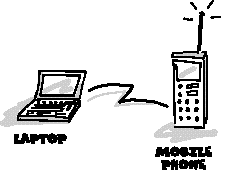
(Figure 4-14) Interfacing the data channel of a mobile telephone with a computer.
This approach is good as long as the requirements are matched by the capabilities of the modems installed in the network. In the assistive technology area there are already examples of devices transferring images from a person with a mobile phone unit, through the data channel, to a service centre that can give advice based on picture contents.
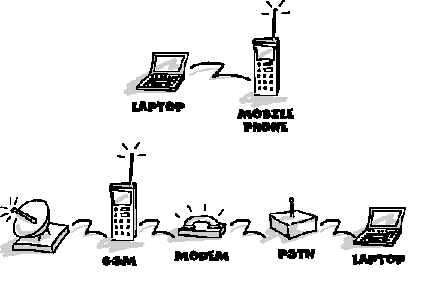
(Figure 4-15) Communication with a computer in the wired network through a mobile telephone.
In other cases the approach causes new obstacles. This is the case for text telephony with most text telephones that are not compatible with normal modems. Therefore the text telephone users suffer from limited accessibility to the GSM mobile telephony. This limitation could be relieved by installing V.18 modems in the GSM interworking units (see chapter 4.1).
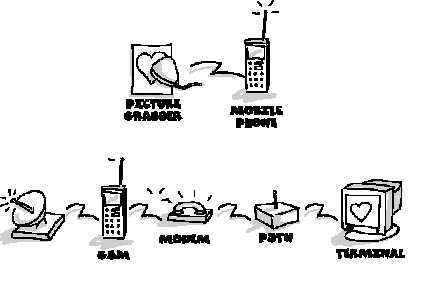
(Figure 4-16) Image transfer with a mobile telephone.
Another form of simple data communication in the GSM network is via the short message service, that can be handled directly from the phone or from a connected computer. This service can be used for message based communication to people with GSM phones. A service for access from text telephones for the preparation of such messages would be of interest for the text telephone users.
General Problems - Size, Keyboards and Prices
Some disadvantages stem however from the small size of the normal mobile telephony devices.
Small keyboards are an obstacle to many disabled users. The small size of the keys and the non-uniform identifying characters and symbols make the mobile phone not very inviting to visually or mobility impaired users.
A standardization of the keyboards is therefore required, that includes the introduction of special identifying tactile and/or visual marks over some important keys (like for example, "off hook / on hook").
The possibility should also be considered for providing a simple keyboard version, sometimes with only one-button and a special operating system, in order to make it usable by a range of users that could get confused by a normal keyboard during the event of an emergency situation, or when the need for a fast call would arise.
Personalized keyboards (see chapter 4.8 on smart cards and terminals) should also be allowed in the standards in order to cope with the needs of specific users, for instance, elderly persons that normally require only certain types of calls, or possibly, sequences of calls, when looking for help or assistance.
The small size displays also prevent some users from accessing the information content easily. An optional character set with a large print size and a scroll facility should be available. The possibility of connection to an external display device to suit specific needs would also be very useful.
Although prices of mobile phones are coming down, they are still quite high, which represents a substantial barrier for their use by disabled persons who in general also have limited financial resources. Calls and network services are also quite expensive. The price of a local call in a cellular mobile network is as a rule much more expensive than a call with the same duration but made in the PSTN (Public Switched Telephone Network).
Set-up Phase of Modern Mobile Communications
According to the EU-Commission's green book on mobile communication close to 80% of the Europeans will use some kind of personal communication in the year 2010. This corresponds to 200 million users. By way of comparison, there are currently 153 million subscribers with the commonly known wired telephones. Furthermore, it is expected that GSM-telephones will replace the public pay phones in many environments. Some operators also forecast that they will replace PSTN phones.
Today, 16 million Europeans use mobile phones, including both conventional analogue and digital GSM telephones, pagers and equipment from what are know as closed mobile radio systems, such as those used for example by the police and the taxis companies. In less than six years the total number for these categories will be just under 40 million users, and double that number in 2010 (CEC, 1994).
However, more new technological wireless possibilities will emerge. Apart from GSM mobile phones, wireless DECT (Digital European Cordless Telecommunications) telephones will supplement and possibly replace wired telephones in the office or at home.
It is therefore predicted that mobile phones will be widely used in Europe, which is why the focus must be on the accessibility aspects for users, including elderly and disabled people, in order that all users all over Europe gain access to the new technological wireless possibilities.
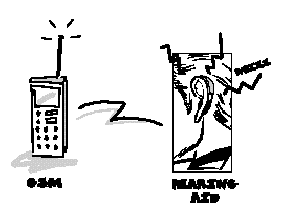
(Figure 4-17) The GSM mobile phones interference with hearing aids requires a solution.
GSM and DECT Technology
The conventional mobile phone systems and the closed land mobile network are characterized by their use of the radio media for transportation of the conversation. In the public systems, two separate systems are used, that is to say, two carrier waves with each their own frequency, one in the direction from the mobile phone to a regular subscriber and one from the regular network to the mobile phone. This ensures that duplex communication is available as is the case with conventional telephones, allowing both subscribers to talk simultaneously.
GSM
When the common European mobile phone system within the international framework in 1982 was to be specified, the starting point was partly a disconnected set of frequency bands in the 900 MHz area for use all over Europe, and partly an anticipation that the mobile phone density would be very high. Therefore, a European special group was set up for specification work formerly called Group Special Mobile.
In 1987 the group chose a system based on the Time Division Multiple Access (TDMA) principle. It is a system in which each frequency channel is divided in 8 time slots. This means that one conversation alone occupies one time slot in each speech direction and that the transmitter therefore is only active in one time slot per division. The modulation form used within every single time slot does not give cause for amplitude variations. However, the effect of the transmitter being active once for each time slot corresponds to an almost square amplitude modulation, which is repeated about 217 times per second.
DECT
A digital wireless telephone system for which a great future is predicted. The staff in companies switching to DECT technology will be equipped with a wireless tele-phone and will therefore be able to answer telephone calls without having to be near the conventional system of transmission lines. The DECT system can be elaborated so that absolute wireless switching systems can be established.
DECT works on double the frequency of GSM and with lower transmitting effect also using a time division principle TDMA, as in GSM. As opposed to GSM, DECT uses the repetition frequency 100 Hz compared with 217 Hz in GSM.
Interference to Hearing Aids
In hearing aids there are transistor amplifiers which may be sensitive to the incidence of radio signals.
If the signals come from conventional mobile phone systems, the resulting interference from the incident radiation, which may occasionally cause distortion or in extreme cases blockage of the amplifier, is usually perceived by the hearing aid users to be less disturbing than the interference caused by the amplitude modulated signals such as those used, for example, in GSM and DECT systems where a disagreeable humming sound corresponding to the time division signal of 217 Hz for GSM and 100 Hz for DECT can be heard.
The disturbances may arise if a GSM/DECT telephone is used very closed to the hearing aid, for example if the hearing aid user himself uses this type of telephone.
Disturbances to other equipment have also been reported, among which is interference to several type approved analogue PSTN telephones (Hauger, 1992).
Measuring the Interference
The latest document statement work comes from a Danish study. Studies of the extension of the problem have previously been carried out in England and Australia (Currie, Woodsend, 1993), (Burwood, Le Strange, 1993). In the Danish study 50 types of hearing aids were measured which in total represent 90% of the hearing aids issued in the period 1991 to 1993 (Nat. Telec. Agency, Denmark, 1993 and 1994).
The result of the study shows that about 60% of the hearing aids will not be influenced by other people's use of portable 2 W GSM telephones, if these are more than one metre from the hearing aid.
As regard to DECT telephones it is not anticipated that hearing aid users will be disturbed by other people's use of these telephones.
However, it is important to keep in mind that the study likewise shows that about 60% of the hearing aids cannot be used together with a portable 2 W GSM telephone.
At the same time the study reveals that about 80% of the hearing aids cannot be used with a portable 2 W GSM telephone at the same ear as the hearing aid. Similarly, it is evident that about 70% of the hearing aids cannot be used together with a DECT telephone of a conventional type at the same ear as the hearing aid.
The study has also revealed that there is big difference in the immunity of the different hearing aid types. Hearing aids of the "in-the-ear" type are the most immune and there is significant difference of these types and the "behind-the-ear" types. It has to be mentioned though that the "in-the-ear" type cannot be used to compensate for all kinds of hearing loss.
Discussion
A conservative estimate says that there are at least 7 million hearing aid users in the EU (Gill, 1994). Seen from the point of view of these hearing aid users, it is a serious problem that they are, to a great extent, not able to use the new wireless mobile phones. For instance, the extension of DECT in connection with the anticipated introduction of wireless switching system (PABC) in the work environment could have serious consequences for hearing aid users regarding employment. This will partly influence many hearing impaired people's working capacity, significantly reducing their quality of life.
The Danish report calls attention to certain possible solutions which incur construction changes in the hearing aids. Furthermore, a standardization work is in action with elaboration of a product-specific EMC standard for hearing aids.
IEC TC29 Electroacoustics WG13 Hearing Aids has produced a second draft of a standard IEC 118. Hearing Aids, Part 13. This standard describes methods of measurement of interference from GSM type signals up to 2 GHz. It also proposes levels of immunity for hearing aids.
Two classes of immunity are proposed. Class 1 is for immunity from users of mobile phones. Class 2 is hearing aids to be used with GSM mobile phones. No specification is currently given for class 2. It is intended to have an international standard available by the end of 1995.
Other Accessibility Issues
A number of actions should be taken by several entities in order to establish an acceptable level of accessibility of disabled users to the mobile phone devices and services.
At the portable device level the introduction of some form of acoustic feedback for keyboard pressing would be very useful for blind users, also, the improvement of contrast of keys and symbols is important for partially sighted persons as well as the use of large print characters in the Liquid Crystal Display (LCD) display.
Still at the mobile phone level, the operating system with menus and options of different levels, requiring several answers to get one function is not the appropriate interface for elderly and persons with minor cognitive disabilities. The programmed time-outs are often too short for many users. The introduction of personalized time-outs, and customized operating systems, for instance through the user's card, will greatly improve the interface for people with special needs.
Some hard of hearing persons wearing hearing aids, as long as they are immune to the radio frequency emission produced by the mobile phone, can benefit from the introduction of inductive coupling in the set. The relevant standards should be reinforced in this as well. Pick-up by the usual coil at the hearing aid would then be used.
The portability of mobile phones allow hearing impaired users to look for a more quiet place for use of the phone, instead of fixed phones that many times are difficult to use because of ambient noise.
Sound amplification is also needed for hard of hearing persons who do not use a hearing aid.
A custom voice control device (through a lap-top computer, for instance), digitally connected to the mobile phone, could be useful for motor impaired persons who also are speech impaired.
Interface to other Equipment, Text Telephony, Standardization
For a large variety of applications of the mobile phones the expansion with additional devices is required for interface or other purposes. For this, there is only one known standard proposal (SMGTS 0705) for Short Message Services (SMS), still not for other services.
Also, a proposal of set of modem AT commands (80 commands) for mobile phones digital interface was recently issued by one of the leading manufacturers.
Text telephony is also possible as long as the portable device possesses a reasonably good keyboard. Some manufacturers have already presented full keyboard devices.
A thorough evaluation of the standards and protocols situation is required in this field in order to avoid confusion and conflicting solutions.
Future Technology (Standards and Services)
Spread-Spectrum Technology
Spread-spectrum (radio) signals, as opposed to the mainstream narrow-band approach, are distributed over a wide range of frequencies and then collected onto their original frequency at the receiver and so are incon-spicuous to the point of being almost "unnoticed" by third parties and unlikely to interfere with other signals - even those transmitted on the same frequencies.
Such an advantage opens up the possibility of increasing the number of user channels and cellular services for voice and data communications thus offering the opportunity of increased accessibility and use to disabled and elderly people, basically in terms of an adaptable and configurable personal communications network.
Present cordless telephony provides home and office instant communications mobility. Wireless Local Area Networks (WLANs) are being used for high-speed data networking, mainly inside buildings. Cellular telephony services and paging systems provide communications coverage virtually everywhere between main destina-tions. It will be easier and easier to place and receive calls throughout the day on portable personal telephones that either access a building network or a so-called Personal Communications Network (PCN), or to carry a notebook or palm-sized personal digital assistant, with a wireless interface that provides access to a range of personal information and messaging services.
Irrespective of a person's location, voice telephony and data transfers are equally supported by the wireless links.
This trend is of particular importance for persons with disabilities, for instance mobility impaired and blind persons, as well as elderly people who require or can benefit from mobile communications facilities.
The non-interfering qualities of spread-spectrum technology could greatly expand the number of voice and data services accommodated.
Growth in dimension and intelligence will lead to from each subscriber being, in concept, a free-travelling individual rather than a localized terminal user.
CDMA and Hearing Aids
In the case of Spread-Spectrum mobile radios, the CDMA multiplexing scheme does not produce low-frequency time varying deterministic signals, but instead signals that look like random noise. This, in principle, is not capable of producing any noticeable proximity interference except for a small increase in background noise.
When available, a CDMA system could immediately alleviate the interference problem and also increase the portability of cellular telephones. These are obvious benefits for a range of people with disabilities.
In 1992, the Telecommunications Industry Association (TIA) formed a Wide-band Spread-Spectrum Committee to develop a standard based on CDMA technology and techniques. An interim standard (IS-95) was approved in July 1993.
In terms of data rate, without spread-spectrum modulation, in an indoor non-equalized channel, data rates up to only 300kbits/s can be supported (AT&T, 1993) due to the influence of echoes and multipath fading. Due to inherent spread-spectrum path resolution properties, a 2Mbit/s data rate can be achieved with an 11 MHz spread-spectrum bandwidth.
The capacity of spread-spectrum CDMA cellular systems is expected to be 85 subscribers per cell per 1.25 MHz, or five times the capacity of TDMA (Time Division Multiple Access) systems (AT&T, 1993).
Universal Personal Number
The introduction of the Universal Personal Number (UPN) will allow a specific user to be contacted wherever he (she) is along the full telecommunications network, not only in the specific network of the caller. This facility stems from the increased power of the digital networks management systems. In particular, for mobile telephony, the universal access to all types of networks turns it more into a highly valuable and effective system.
Conclusion
The introduction of mobile telephony has brought a wide range of new possibilities for disabled and elderly people in gaining access to telecommunications in general and to specific services and facilities, in particular. Not only voice but also data services will be provided over the wireless networks allowing a wide range of applications to be built upon them and extending the operation "seamlessly" to most places. Many applications and interface situations have been presented. A wide range of alarm services, location independent messaging, telemetry, remote surveillance and care are possible. Of fundamental importance, however, is that the specific interfaces required for each type of disabled user must be adequately further developed in order to become coherently attached to the portable phone hand-set.
However, some problems remain, one of which is the problem experienced by hearing aid users being affected by the radio frequency emission of the GSM mobile phones. A conservative estimate says that there are at least 7 million hearing aid users in the EU. Seen from the point of view of these users, it is a serious problem that they are, to a great extent, not able to use the new wireless mobile phones. The Danish report calls attention to certain possible solutions which incur construction changes in the hearing aids. Furthermore, a standardization work is in action with elaboration of a product-specific EMC standard for hearing aids.
With an increased capacity over TDMA and analogue systems, spread-spectrum CDMA may replace TDMA in the future, as signal quality slowly decreases or gradually becomes noisier as more users are added. It could also virtually eliminate the hearing aid interference problem.
A global perspective of mobile telephony still needs to be further elaborated in order to reach a coherent standardized mobile telephony system where connec-tion to other media is natural and additional facilities are welcome.
AT&T, (1993). AT&T Technical Journal, July/August 1993.
BURWOOD, E. and Le STRANGE, R. (1993). Interference to hearing Aids by the new Digital Mobile Telephone Systems, Global Systems for Mobile (GSM) Communications Standard. National Acoustic Laboratories, Sidney.
CEC, (1994). Towards the Personal Communications Environment: GREEN PAPER on a common approach in the field of mobile and personal communications in the European Union. COM(94) 145 final.
COST 219, Ed. by GILL, J. (1994). The forgotten millions: Access to telecommunications for people with disabilities. Published by The European Commission, DGXIII.
CURRIE, K., WOODSEND, K. (1993). Results from a hearing aid user trial on the Cellnet GSM network. British Telecommunications plc.
HAUGER, E. (1992). Interference from TDMA structure in a digital mobile communication to PSTN. Norwegian Telecom research, TF R 40/92.
IEEE Transactions on Communications, May 1982.
IEEE Journal on Selected Areas in Communication, May-June 1990.
NATIONAL TELECOM AGENCY, Denmark, (1993). Hearing aid interference by GSM cellular mobile telephones. Working group report on GSM cellular and hearing aids.
NATIONAL TELECOM AGENCY, Denmark, (1994). Interference with hearing aids caused by GSM digital cellular telephones and DECT digital cordless telephones. Conclusive report by the working group on GSM and DECT telephones and hearing aids.
SCHILLING, D.L., PICKHOLZ, R.L., MILSTEIN, L.B. (1990). Spread Spectrum goes commercial. Published in IEEE Spectrum, August 1990.
TAUB and SCHILLING, D.L., (1986). Principles of Communication Systems, 2nd ed., McGrawHill.
VINCENT, J. (1993). Voice link with spread spectrum radio. Published in Electronics and Wireless World, September 1993.